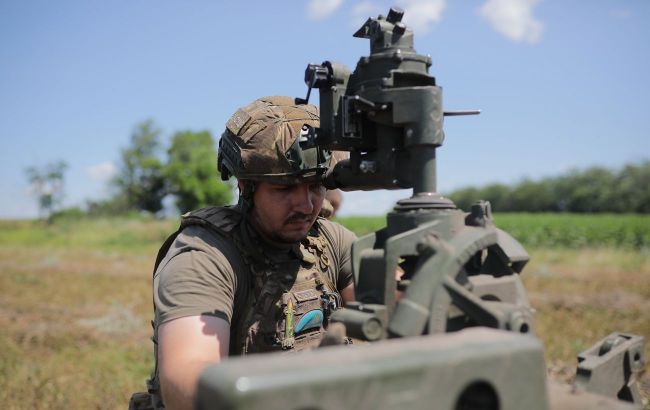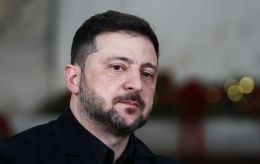Moment of truth: How the fall starts for the Ukrainian forces and where new breakthrough possible
 Ukrainian military forces are breaking through the Russian defense in the south (photo: Getty Images)
Ukrainian military forces are breaking through the Russian defense in the south (photo: Getty Images)
Ukrainian forces are holding back Russians in the east and breaking through to the second line of defense in the south. Learn more about the situation on the front and what to expect from the fall offensive campaign in the material by RBC-Ukraine below.
Hot East. Movement near Bakhmut and the Kupiansk-Svatove-Lyman line
The Lyman-Kupiansk axis remains one of the most tense areas. Here, the enemy has focused on offensive actions.
"In the Kupiansk direction, our defense forces repel several enemy attacks a day and prevent the enemy from advancing. The number of shelling from the Russians remains high," says Deputy Minister of Defense Hanna Maliar.
The Russian side claims to have control over the village of Synkivka near Kupiansk, but this information is unconfirmed. Analysts from the DeepState project emphasize that the occupiers cannot gather enough strength to advance on Kupiansk.

The Russians claim to have control over Synkivka near Kupiansk, but the information is not confirmed (photo: deepstatemap.live)
In the Lyman direction, there are ongoing regrouping and enemy attempts to advance in the areas of Bilohorivka and Novoiehorivka (Luhansk region). According to the chief spokesperson of the Eastern Group of the Armed Forces of Ukraine, Ilia Yevlash, the Russians constantly carry out airstrikes and, on one day, stormed Ukrainian positions eight times. A real battle with tank engagements has unfolded near Novoyehorivka.
"Out of seven destroyed tanks, two were modern T-90 'Proryv'," he commented on the enemy losses. Later, a video of tanks being destroyed by soldiers from the 43rd Separate Artillery Brigade appeared on the internet.
Battles for Novoiehorivka are ongoing continuously as the enemy seeks to push the Ukrainian Armed Forces away from river crossings across the Zherebets River, which they use to transport their reinforcements. The goal of this advance is to break through to the Oskil River.
Last week, the enemy attempted to capture the height of 190.8 north of the village. All attacks were repelled, and the Russians were forced to retreat to the east. Drawing definitive conclusions at this stage is premature.
"The fighting is primarily for heights, not for populated areas, because it allows to control the surrounding situation. Classic tactics involve taking more advantageous tactical lines and positions, and this primarily means dominant heights," explained expert Vladyslav Seleznov to RBC-Ukraine.

The epicenter of the battles on the Svatove front is the village of Novoiehorivka (photo: deepstatemap.live)
Military and political expert of the Information Resistance Group, Oleksandr Kovalenko, notes that the media usually focus on populated areas. Of course, personnel and equipment are placed in villages, turning them into strongholds and fire positions. However, the main focus is on geography, landscape features, and heights.
"Heights are important for the Russians because, on the Lyman-Kupiansk axis, they have to advance from open positions in lowlands. Therefore, they cannot fully realize their limited offensive potential. According to available information, their situation is not the best with the 4th Tank Division, which is suffering serious losses. It is doubtful that the enemy will be able to break through our defense," he said, expressing doubt that the enemy can break through our defense.
Further south, enemy artillery has become active in the Serebrianske forest. According to DeepStatе analysts, in the second half of July, the enemy managed to breach the positions of one of the brigades near Lyman. However, further advance was stopped almost immediately.
As for Bakhmut, the Russians are concentrated on defense, holding back Ukrainian forces on the northern and southern flanks. Hanna Maliar speaks of Ukrainian successes in the Klishchiivka area. According to her, in a week near Bakhmut, an additional 3 square kilometers of territory were liberated, making a total of 47 square kilometers since the beginning of the offensive.
Southern Front. Russians breaking through the main defense line
The good news is coming from the Melitopol direction, where our troops are advancing successfully in Novodanylivka and Novoprokopivka (Zaporizhzhia region) and are consolidating new positions.
"The enemy in the south is suffering significant losses in personnel, equipment, and machinery, and is moving units and troops, using reserves," Maliar noted.
The main battles are taking place south of Robotyne, northeast of Novoprokopivka, and west of Verbove. Recently, a video emerged showing the 44th artillery brigade destroying a column of Russian trucks with infantry to the south of Verbove.
Interesting details about Robotyne were revealed by the Minister of Foreign Affairs, Dmytro Kuleba. According to him, one of our units unsuccessfully attempted assaults for several months until the command was changed.
The new command formed a combined group of over 30 motivated fighters. They, in 18 hours, crawled through minefields, reached the landing site, eliminated the Russians, and held the position for two days until reinforcements arrived.
After that, the group advanced another 10 kilometers through minefields, stormed fortifications, and held the line until the main forces approached. Three dozen fighters accomplished the work of a battalion, with 7 wounded.
"In fact, the work of this group enabled the advance of an entire brigade on Robotyne and its liberation. After securing its flanks, we open the way to Tokmak and ultimately to Melitopol and the border with Crimea," the minister added.
The result is the breakthrough of the so-called "Surovikin's lines." Currently, our troops have advanced approximately 1.5 kilometers to the south and southeast towards Novoprokopivka. They are expanding their foothold in this sector.

Ukrainian forces are expanding their foothold between Robotyne and Verbove (photo: deepstatemap.live)
The commander of the Tavria Operational Strategic Group, Oleksandr Tarnavsky, says that the Ukrainian Armed Forces are positioned between the first and second lines of defense. According to him, Russia spent about 60% of its time and resources on the first line, and 20% each on the second and third lines. Therefore, our troops can break through faster.
Expert Oleksandr Kovalenko believes that the marker for the next breakthrough will be the liberation of Tokmak, its operational encirclement, or an advance to the south of the T0401 Tokmak - Polohy road.
"When can we do this? Making forecasts is a thankless task. But in general, according to the movement observed on the left flank, this can happen by the end of September. That is, a breakthrough of the second line in September, and the advance to the third line should start in October," he noted in an interview.
Vladyslav Seleznov is less optimistic. According to him, there are many variables in this equation, and it's difficult to say whether the Ukrainian army has the resources to sustain the intensity of operations, especially against the backdrop of Western partners cautiously perceiving the change in leadership of the Ministry of Defense.
The New York Times draws attention to a change in Russian defensive tactics in the south. In particular, occupiers are flooding minefields with easily flammable substances. And when Ukrainian sappers begin demining, they drop grenades from drones, "igniting a sea of fire and explosions."
In Seleznov's opinion, this is most likely not a constant practice but isolated incidents.
"Let's imagine: they set fire to minefields and detonate everything they've planted in our land. In fact, the fields become demined, and there is no threat to our advance. If this is what's happening, then the ignition of minefields can be called the 'last-ditch attempt,' when the enemy resorts to such measures in a critical situation. Today, everything explodes, and tomorrow it's just a scorched field with no obstacles to our progress. It's quite a strange tactic," the expert emphasized.
What can be said with confidence is the acceleration of the pace in the Melitopol sector. And, most likely, the fate of the advance to the south depends on events near Robotyne, Verbove, and Novoprokopivka.
The head of the Center for Military-Political Studies, Oleksandr Musiienko, suggested that the enemy is weakened there and cannot offer strong resistance.
"What we are talking about - Verbove, Novoprokopivka, and other settlements - is the expansion of our foothold, the goal of which is to secure the flanks and advance deep into the defense of Russian forces," he told RBC-Ukraine.
Gray zones on the left bank of the Dnipro River
Despite the information silence, Ukrainian forces are conducting operations on the left bank of the Dnipro River in the Kherson region. Last week, a video emerged showing a blue and yellow flag flying over the "Dorozhnyk" garden cooperative, located 3 kilometers from the occupied town of Oleshky.
The situation near the village of Kozachi Laheri, where a landing was previously carried out and a Russian officer was captured, remains unknown. At the same time, so-called "war correspondents" report a supposed landing near the village of Pidstepne to the northeast of Oleshky. On the DeepState map, this area is marked as a gray zone.

To the northeast of Oleshky, a new gray zone has appeared (photo: deepstatemap.live)
The expansion of the gray zone does not equate to the establishment of a foothold. Operations are conducted by limited forces in a sabotage and reconnaissance format, and after completing their combat tasks, they return.
"What is a foothold? It is an area where personnel, tanks, artillery, MLRS, and anti-aircraft missile systems are deployed to cover the advance from the air. Do we see our tanks on the left bank? No, so it is not a foothold. We are expanding the gray zone, preventing the Russians from restoring their first line of defense, exerting fire control, but not fully controlling the area. Although all gray zones have a very important property: sooner or later, they change their color," explains Oleksandr Kovalenko.
Shaheds fall, Romania closes its eyes
On the night of September 4, Russia launched drone attacks on the Odesa and Dnipropetrovsk regions. In total, 32 Shaheds were launched, with 23 of them successfully shot down.
Southern Odesa region was attacked in several waves, and enemy targets moved along the border with Romania. The attacks resulted in damage to warehouses, industrial and agricultural buildings, and equipment of agrarian and industrial enterprises, including the port of Reni. There were no casualties or injuries.
However, this time, some of the drones fell and exploded on Romanian territory. At least, that's what Ukraine claims.
The spokesperson for the Ministry of Foreign Affairs Oleh Nikolenko stated that this happened during an attack on the port of Izmail. This once again confirms that Russian UAVs pose a threat not only to Ukraine but also to neighboring countries.

Shahed drones crashed on Romanian territory (photo from Oleh Nikolenko's Facebook page)
As noted by the Head of the United Coordinating Press Center of Security and Defense Forces of the South of Ukraine Natalia Humeniuk, it's not the first time the enemy has used geographical features and laid a trajectory as close to the border as possible. In the Reni and Izmail regions, the distances are so small that the consequences of strikes can indeed pose a threat to Romania.
"The fact has been recorded, the neighboring country has been informed that such a danger exists, and we have recorded hits... Further response should be by the neighboring country," she noted.
Andriy Yermak, the head of the President's Office, proposed strengthening sanctions against Russian defense, depriving them of the ability to launch drones and missiles, and providing Ukraine with more air defense and long-range missile systems. In his opinion, this is the only way to stop the aggressor.
However, we shouldn't expect a special reaction. Romania's Ministry of Defense denies the drone crashes. In its statement, it claims that the information from the Ukrainian side allegedly does not correspond to reality, and Russia has "never posed direct threats" to Romania's security.
According to Oleksandr Kovalenko, they expected stronger words from Bucharest, but instead, it showed a spineless position.
"This doesn't mean they had to declare war or invoke Article 5 of the NATO treaty on collective security. It means that Romania should firmly state its opposition to the use of its airspace for attacks on Ukraine," the expert expressed his frustration.
He also emphasized that Ukraine cannot shoot down such objects because if they fell on Romanian territory, they must have been in Romanian airspace at some point.
"What does this indicate? Romania, having such a precedent, has shown weakness. This surprises me because they have nothing to fear. What would Russia do? Launch a missile strike on Bucharest? No, nothing like that, but our neighbors initially did not acknowledge that rockets enter their airspace, and now they don't acknowledge the Shaheds, despite the evidence. It doesn't look funny, it looks very sad," Kovalenko added.
Oleksandr Musiienko reminds that such incidents have occurred on the territory of NATO countries before.
"I think this (Romania's statement - Ed.) is related to NATO's position. They consciously turn a blind eye to incidents they consider minor to avoid escalation with Russia. But it must be understood that the more they close their eyes, the more Russia will allow itself in the future," he noted.
***
One of the achievements of the summer campaign was the breakthrough of Russian defenses in the south, which objectively opened up opportunities for further offensive actions. Decisive battles lie ahead, unfolding on the main line of the occupiers' defense. In the direction of Tokmak, Ukrainian troops have already breached the first positions of this line in some places. Something similar happened in November 2022 when our units liberated Kherson. The enemy did not have such a prepared defense there, and we did not have the resources we have today. However, the Kherson operation itself also started in the summer. Whether such success will be repeated in the Azov Sea area will become clear in the coming weeks.

